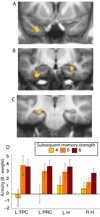Activity in both hippocampus and perirhinal cortex predicts the memory strength of subsequently remembered information
- PMID: 18760691
- PMCID: PMC2614916
- DOI: 10.1016/j.neuron.2008.07.022
Activity in both hippocampus and perirhinal cortex predicts the memory strength of subsequently remembered information
Abstract
It has been suggested that hippocampal activity predicts subsequent recognition success when recognition decisions are based disproportionately on recollection, whereas perirhinal activity predicts recognition success when decisions are based primarily on familiarity. Another perspective is that both hippocampal and perirhinal activity are predictive of overall memory strength. We tested the relationship between brain activity during learning and subsequent memory strength. Activity in a number of cortical regions (including regions within the "default network") was negatively correlated with subsequent memory strength, suggesting that this activity reflects inattention or mind wandering (and, consequently, poor memory). In contrast, activity in both hippocampus and perirhinal cortex positively correlated with the subsequent memory strength of remembered items. This finding suggests that both structures cooperate during learning to determine the memory strength of what is being learned.
Figures




Comment in
-
Recognition memory: can you teach an old dogma new tricks?Neuron. 2008 Aug 28;59(4):523-5. doi: 10.1016/j.neuron.2008.08.004. Neuron. 2008. PMID: 18760687 Free PMC article.
References
-
- Baker JT, Sanders AL, Maccotta L, Buckner RL. Neural correlates of verbal memory encoding during semantic and structural processing tasks. Neuroreport. 2001;12:1251–1256. - PubMed
-
- Binder JR, Frost JA, Hammeke TA, Bellgowan PS, Rao SM, Cox RW. Conceptual processing during the conscious resting state. A functional MRI study. J Cogn Neurosci. 1999;11:80–95. - PubMed
-
- Brown MW, Aggleton JP. Recognition memory: what are the roles of the perirhinal cortex and hippocampus? Nat Rev Neurosci. 2001;2:51–61. - PubMed
-
- Buckner RL, Andrews-Hanna J, Schacter DL. The brain's default network: anatomy, function, and relevance to disease. Annals New York Academy Sciences. 2008 - PubMed
-
- Buckner RL, Wheeler ME, Sheridan MA. Encoding processes during retrieval tasks. J Cogn Neurosci. 2001;13:406–415. - PubMed
Publication types
MeSH terms
Grants and funding
LinkOut - more resources
Full Text Sources

